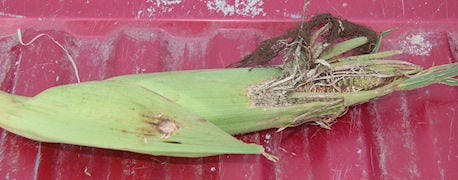
You name it, and you're likely to find it, even in fields that haven't been wiped out by the drought. You'll find kernel tip abortion or tips that never pollinated. You can tell the difference by whether or not silks are still attached to the tip of the ear. If they are, pollination never occurred. If not, the plant decided as it went through grain fill, from the butt end up, that by the time it got to the tip, it didn't have enough resources to finish those kernels. So it pulled back, let those kernels abort and devoted its resources to protecting kernels it could produce.

Bird damage: Birds attacked this ear, shredding the husks. That opens the ear up for diseases.
"The plant has a strong will to produce progeny," says Dave Nanda, director of agronomy and technology for Seed Consultants, Inc. "It will cannibalize other parts of the plant and even abort kernels if conditions aren't favorable and it believes it needs to do so to produce as many viable progeny as it can."
In a non-GMO field, we found a classic shot of an ear worm feeding inside an ear. However, the damage was not widespread. It tended to be worse on smaller ears that weren't pollinated well anyway.
Bird damage was obvious in some cases, especially on the outer rows, and on fuller ears. Birds tend to attack the tips, and tear back the shucks. This can open up the ear for diseases later on, or even for sprouting if it rains and rain sets in the ear.
One thing we saw little of was smut. It's more common in years when there is flooding early. However, while scouting a large field, we did find one stalk with smut where the ear should have been. Smut should not be the cause of many problems this year.
We also found one ear coming out where the tassel should have been. The stalk was only a couple feet tall. It's a year when you shouldn't be surprised by anything you find in the field.
About the Author(s)
You May Also Like




